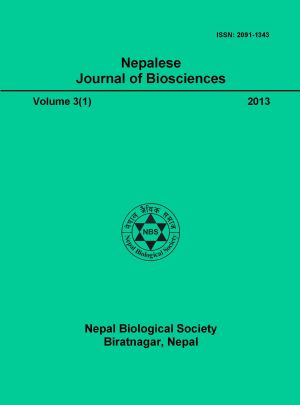Soil microbial biomass in cropland and forest ecosystem in eastern Nepal
DOI:
https://doi.org/10.3126/njbs.v3i1.41449Keywords:
Cropping system, tropical moist forest, landslide, restorationAbstract
Soil microbial biomass carbon (MB-C) and nitrogen (MB-N) were estimated in some man-made cropland ecosystems and Sal forest natural ecosystem in eastern Nepal. In these cropping systems MB-C ranged between 244 µg g-1 and 425 µg g-1 soil, minimum in tea cultivation and maximum in uncultivated paddy field. MB –N ranged from 24.7 µg g-1 to 43.2 µg g-1 soil, which was minimum in paddy field at mature crop stage and maximum in uncultivated paddy field. Towards natural ecosystem five landslide damaged sites selected in Sal forest ecosystem were 1 yr., 4yr., 15yr., 40yr., and 58-year old. Under these sites MB-C was minimum (132μg g-1) in 1-yr old site and maximum (638 µg g-1) in 58- yr old site. Similarly, MB-N was also minimum (14 µg g-1) in 1-yr and maximum (55 µg g-1) in 58- yr old site. In comparison to undisturbed mature Sal forest 58 year old site showed 82 % recovery in soil microbial biomass which indicates the re-establishment of soil nutrients and restitution of nutrients cycling.




